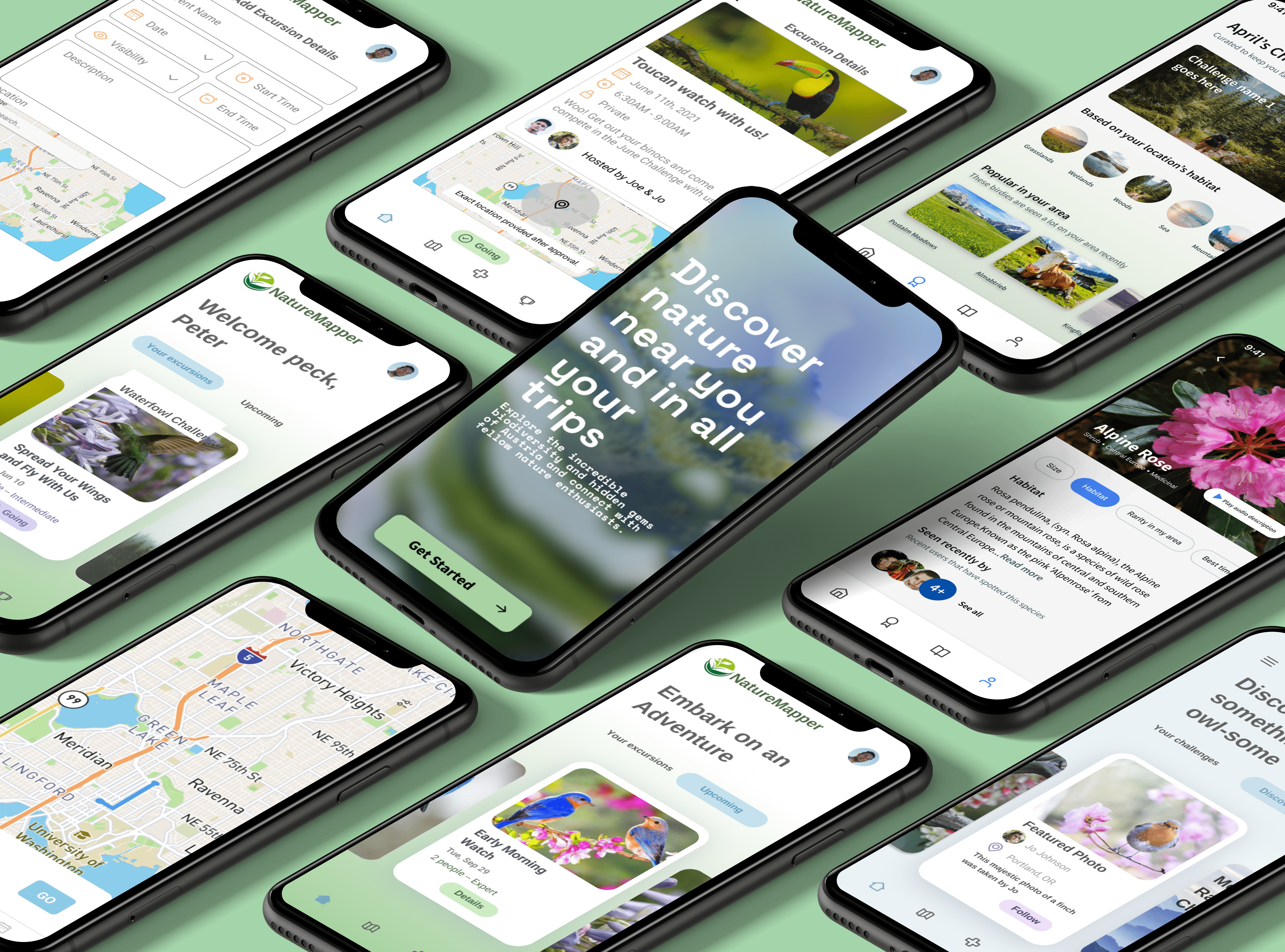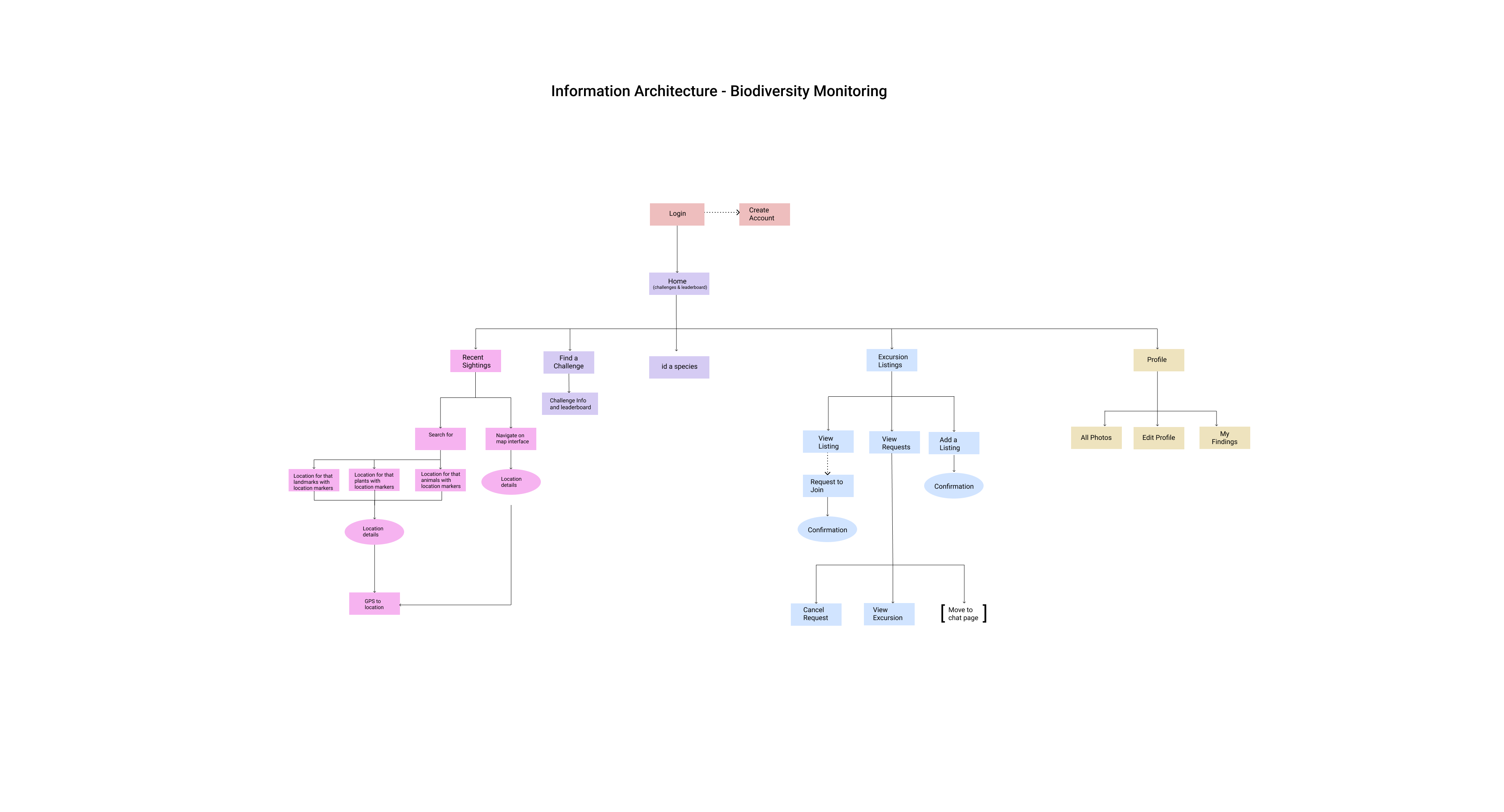
Overview
Become a Citizen Scientist and Contribute to Nature's Conservation. Our biodiversity monitoring app was designed with user experience at its core, providing a seamless and engaging platform for nature enthusiasts to track and share their observations
With our app, you can track and record sightings of a variety of species, from birds and mammals to insects and plants. The app allows you to take photos and upload them along with your observations, creating a comprehensive record of your nature experiences
The Problem
One of the main problems with the previous version of our biodiversity monitoring app was the lack of user guidance and clear instructions. Users often found the app confusing and difficult to navigate, leading to frustration and a poor user experience.
Additionally, the app lacked integration with other devices and services, making it difficult for users to track their observations and sightings over time. Users were also unable to easily share their observations with other apps and services, limiting their ability to contribute to larger research efforts and conservation initiatives.
Design Question
How can we redesign our biodiversity monitoring app to provide clear user guidance, accurate identification tools, and improved social functionality to enhance the user experience and promote biodiversity monitoring and conservation efforts in Austria?
Our Solution
We aimed to make biodiversity tracking accessible to beginners and provide useful features for experts.
The platform eliminates the need for multiple different apps, forums, and community groups from the Austrian Biodiversity Project by centralizing it all into one place.
User Research
Our team conducted five semi-structured interviews using the same set of questions. The aim of our user interviews was to gain a deeper understanding of our users' motivations, pain points, and processes.
KEY FINDINGS
01 "Catch Them All" - It's Like A Game
Participants mentioned that they keep ''life lists" of species they've seen, and this excitement with discovering a new species. One participant noting that they want to "catch them all" in reference to Pokemon.
02 Wish To Meet & Share With Others
Several participants mentioned difficulty finding a nature-watching community. They also mentioned that they enjoyed being able to share their sightings with others, often through social media.
03 Desire To Stay Aware Of Recent Sightings
Participants mentioned different strategies for trying to keep up-to-date with nearby sightings from other nature-watchers, such as looking for tagged Instagram photos of nature that include the location.
Affinity Diagram
After each team member had conducted their interview, we grouped together common findings using an online whiteboard, Miro, to create an affinity diagram.
PersonasThe purpose of our personas was to further understand the goals, pain, desires, and allow us to empathize with the users.
We started off by creating our main persona, Peter, who is a nature watcher hobbyist, based off of a combination of our interviewees. We also created a secondary persona Johana, in order to capture the diversity amongst the nature watching community in terms of experience and goals.
User Journey MapWe developed a user journey map based on the Peter persona. We used our research as well as some of our own outdoor excursion experiences to imagine the course of a day’s nature-watching expedition. Our journey map allowed us to visualize the user’s emotional journey over the course of the experience and aided us in identifying pain points.

Design RequirementsOur design requirements were informed by our user research, personas, and journey map, which all identified key pain points we wanted to address. We wanted to provide the necessary features for a nature watching excursion as well as incorporate novelty through providing a platform for community engagement and interaction.
01 Help users to identify species they find during an excursion
02 Assist users in locating nature watching spots around their area
03 Allow users to contact each other through the platform
04 Let users complete challenges specific to their area
05 Educate users on nature and conservation
Information ArchitectureWe created an informational architecture flowchart to showcase the many ways our users can use our potential nature tracking at a high-level. We wanted to visualize the user flows to identify potential areas of discontinuity in the user experience.

LO-FI MOCKUPS
Transforming ideas into reality
We created lo-fi flows for three of our main features: create a listing, add a sighting, and view recent sightings.
We decided to forgo the challenge feature at this point due to projected time and scope constraints.
USER TESTING & EVALUATION
We conducted this remote study by asking each participant to complete three tasks, with a specific scenario in mind. As participants complete each task, we noted their process and asked various questions about their experience. The suggestions and our observations were used to modify our designs into our next step, annotated wireframes.
Key FIndings
01 Accommodate In Remote Areas Without Service
Many times, people will naturewatch in remote areas where there is no service, so it is important to accomodate for that use case.
02 Want Multiple Methods To Identify Species
Some participants do not have the greatest camera, so they would prefer other methods to identify plants besides just taking a picture
03 Desire To Engage And Grow As A Nature-watcher
Our novice nature-watcher participants noted they wish they had more ways to learn about and experience naturewatching
After feedback, we all agreed to add back in the challenge feature in order to differentiate ourselves from competitors and better fulfill our users' needs. In adding a sighting, we included options for both camera and audio in response to user feedback. We also included an offline mode for nature watchers who explore areas where they won't have service.
Reflection
I was enthralled by the challenge, as a nature and outdoor lover myself, and was very excited to create an app from complete scratch. I think my group's biggest strength was our power of teamwork. Early on we established roles based on our own strengths and goals, such as product manager, lead designer, and lead researcher. Our collaboration was based on open and frequent communication, goal-setting, and inclusion.
It wasn't all smooth sailing though. I think two of the biggest challenges presented by this project were the short timeline and narrowing down the scope. As the lead designer for our group, I wanted to spend more time improving the accessibility of our app and to incorporate some education on nature-watching ethics, to better serve our users, but wasn't able to do to time restrictions.
Though through many late nights and zoom calls, we were able to successfully create a detailed, in-depth high-fidelity prototype that we all are very proud of.